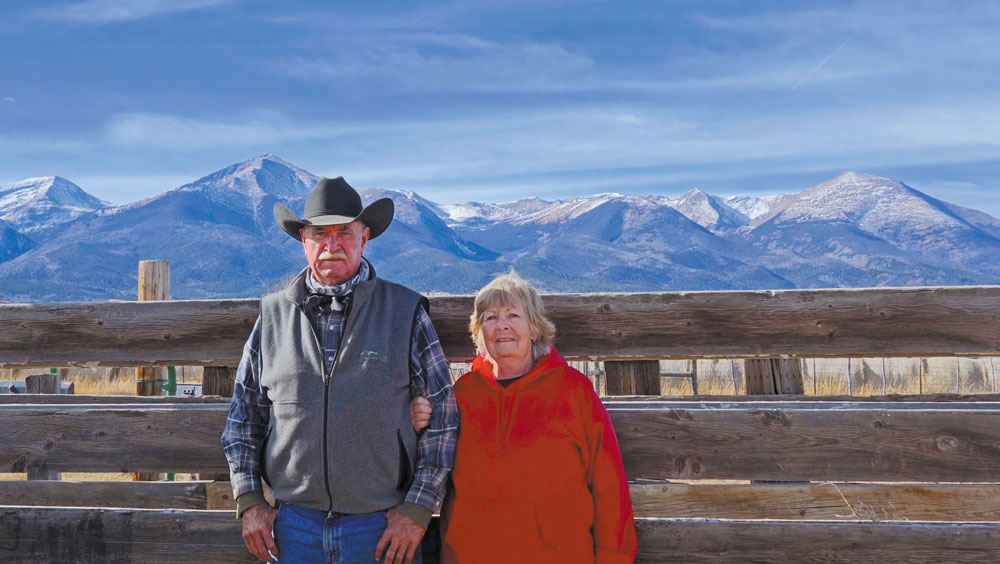By Elliot Jackson
The news coming from the Colorado State Demography Office, by way of a July 2017 article in the Denver Post, is eye-opening: by 2050, the state’s population is predicted to rise to 8.5 million – a 50 percent increase from 2015 levels. Most of this growth is projected to take place along the already highly-developed Front Range, and all of this growth will be, must be, fueled by siphoning more and more water from other parts of the state – water mostly used now for agricultural purposes.
That siphoning has already started to occur in the central Colorado region. In 2013, the CB Ranch in Fremont County, with its attendant senior water rights, was sold to the Security (CO) Water District. Meanwhile, neighboring Custer County was seeing the sale of the H20 Ranch, and its water rights, to the city of Fountain. Water that currently irrigates agricultural production, including the CB Ranch’s hay field, will eventually be diverted to the cities of Security and Fountain, part of the effort to irrigate the Front Range’s population growth.

It is a scenario that helps explain some of the friction between rural and urban in Colorado, as well as in other Western states where water supply is nowhere near adequate to fuel the demand of folks who are flocking to them. Ironically, the folks who are flocking to them seriously threaten the existence of what brought many of them there in the first place: their scenic splendors, and all the farming, hunting, fishing, recreation and other opportunities those scenic splendors contain. The wide-open vistas of places like the Wet Mountain Valley, for example – where cattle still outnumber people, and elk, bear, deer, bobcat and mountain lions are as apt to be your neighbors as humans.
[InContentAdTwo]
Fortunately for the prospects of places like the Wet Mountain Valley, conservation efforts have been well under way for some time. The loss of what little water there is in rural Colorado, and what that loss would mean for the human and other lives there dependent on it, has been one of the major spurs for the development of conservation easements and land trusts, such as the San Isabel Land Protection Trust (SILPT), headquartered in Westcliffe, Colorado.
Basically, says Chris Skagen, SILPT’s interim executive director, “a conservation easement is a promise made by a land owner not to develop certain parts of his or her property, … in perpetuity, out of a recognition that there is a public benefit to certain types of features being preserved.” According to both Skagen and Larry Vickerman, currently president of SILPT’s Board of Directors, “large intact properties with water rights” is SILPT’s number one preservation priority.
Water rights, however, are only part of the picture. As with other real estate deals, location, location, location is a watchword with land conservation. The property’s location – is it adjacent to open space like BLM or National Forest land, or other parcels already in conservation easements? – is a key factor when it comes to evaluating its potential for easement status. The property’s function in the area’s economy is another consideration: Is it a working farm or ranch? Is it part of a wildlife migration corridor, or does it provide other critical wildlife habitat?
Another key factor is historical significance.
Larry Vickerman has deep roots in the Wet Mountain Valley, going back over 100 years. He originally became involved with the San Isabel Land Protection Trust when he began negotiations with them to put the headquarters part of his family’s ranch under conservation easement – 350 irrigated acres including historical buildings. One of the reasons he cited for wanting to work with SILPT is that it is a local organization, started by a group of concerned citizen volunteers in the 1990s. Since that time, SILPT has helped put about 40,000 acres in a four-county service area – Pueblo, Huerfano, Custer and Fremont – under conservation easement.
The whole process in his family’s case, says Vickerman, took about a year. First comes a baseline survey and an appraisal done within 60 days of the easement application. Besides being a way of determining a property’s current worth, says Chris Spraken, the appraisal helps the land trust to determine “what is the value of not developing the land” – in other words, the difference between the land’s current value “as is” and its value after development restrictions have been put in place is the value of the conservation easement. During development boom years, says Vickerman, such as the 1990s until the economic crash in 2008, there was a rush to put land into conservation easements. After the crash, “it was a little tougher to convince people to put easements on because there’s not enough incentive in terms of difference in land values.” With the recovery in land values on the rise again since the crash, however, and the increased pressure from development in other communities, interest in conservation easements appears to be again on the rise.
A conservation easement may be either donated or bought outright, depending on its value. The appraisal and baseline survey process enable the land trust and the land owner to determine not only the value of the conservation easement, but the form of financial compensation the landowner will get for agreeing to waive the property’s development rights. The first type of easement is a donation, where the financial compensation consists mostly of federal and state tax credits. This type of easement, according to Vickerman, works best for “slightly less productive lands” – such as forest or grazing lands with no water rights attached. This type of easement can significantly reduce the owner’s tax burden, and help either mitigate or eliminate altogether the estate tax owed on the property. This in turn can help ranches and farms stay in the family who establishes the easement.
In other cases, as in a property with significant water rights, there is a second type called a purchased easement. The land trust agrees to purchase the conservation easement outright, using grant funding or donations to compensate the land owner.
In addition to purchased easements, and the responsibility of doing baseline reports once a year on existing easements in perpetuity, there are other expenses involved with the conservation easement process, such as fees for attorneys, appraisals, and applications for tax credits. Depending on need, the land trust may not only help shepherd landowners through the easement process, but also help pay for the costs of the process.
Fundraising for SILPT, as for other land trusts, is thus always a priority and a challenge. In addition to grant-writing and soliciting donations, the land trust sponsors two major fund-raising events: Art for the Sangres, held at the end of September in Westcliffe, a fine-arts exhibition and auction; and the Hardscrabble Mountain Trail Run, a 5 and 10K hike/run through the Bear Basin Ranch, held in June. According to Janet Smith, SILPT’s Development Director, the events not only raise money for the land trust, but awareness as well. She sees the most important part of her job as “making the community at large understand what the land trust does, and the issues at stake (in conservation).”
Part of what the land trust does, in addition to purchasing and monitoring conservation easements, is to help their landowners in unexpected ways. Spraken cites the example of one of their largest easement holders, who had 70 percent of his land burnt in the 2016 Junkins Fire. SILPT got grants to fund crews for fire mitigation efforts. “The face of conservation is changing,” he says. “We need to look at other opportunities at stewardhsip.”
There are other organizations besides SILPT at work doing conservation easements: two of the most significant in central and southern Colorado being the Palmer Land Trust and the Colorado Cattleman’s Agricultural Land Trust (CCALT). Local landowners who have worked with all these organizations, such as the Vickerman family, Steve and Nancy Oswald of the Taylor Ranch, and Randy and Claricy Rusk, have helped put the Wet Mountain Valley on the map for excellence in conservation efforts. The Rusks, who were among the first families in the Valley to put their land in easements, have won wide recognition and numerous awards, the latest being the Stuart P. Dodge award for lifetime achievement in conservation. The Oswalds received the 2017 Conservationists Award at the Central Colorado Conservancy’s Annual Event.
The efforts of these families cannot be underestimated when it comes to establishing legitimacy for the conservation movement. In rural Colorado, “how long have you lived here, anyway?” can be a way for long-time locals to shut down debate with “newcomers” about issues of economic growth and change. It is when the long-time locals who, partnering with newcomers, spearhead the movement on these issues, that the most dramatic and long-lasting impacts can be seen.
Chris Spraken sums up a general sentiment among the Wet Mountain Valley residents working in the conservation movement: “We’re preserving what everyone finds so attractive about Southern Colorado – we’re here to support what attracts people, but also the local economy.
“We’re not the answer to everything, but we’re trying to make it viable for people who live and work on the land.”
Elliot Jackson lives and writes in Westcliffe, where she wakes up every day to the stunning vistas of the Wet Mountain Valley. Thank you, land trusts!


